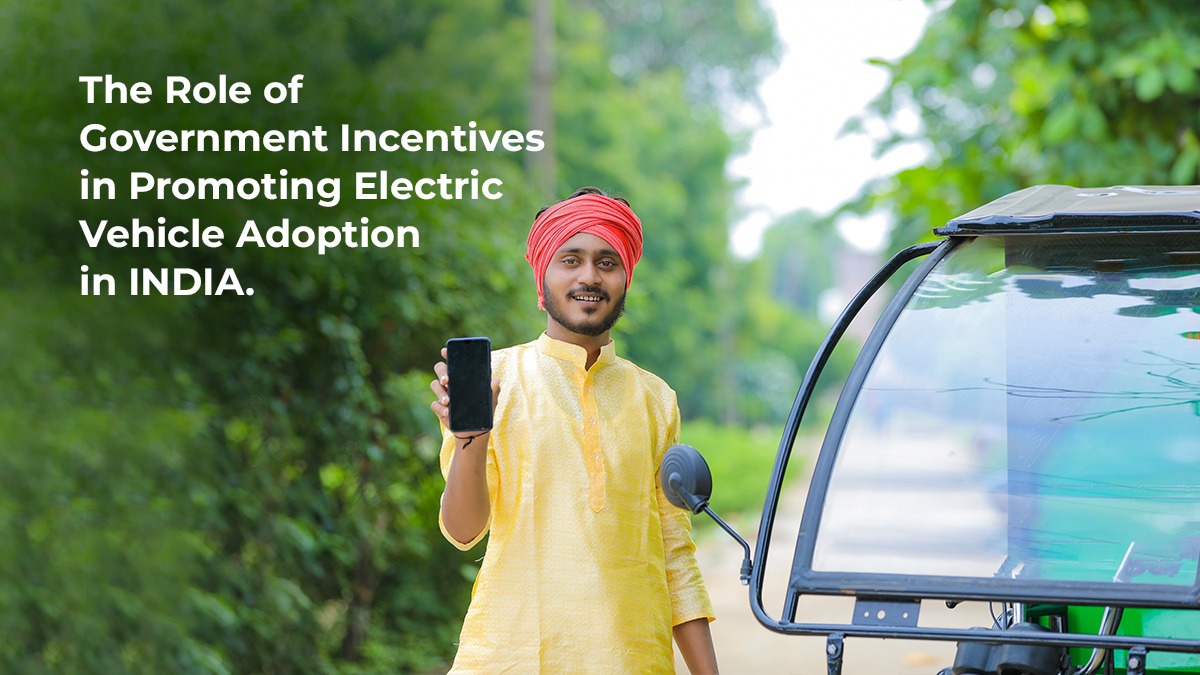The Role Of Government Incentives In Promoting Electric Vehicle Adoption In India
The Indian Government's EV Policy
Electric vehicles (EVs) are increasingly becoming a significant part of the transportation industry in India. In recent years, the Indian government has incentivized citizens to switch from traditional petrol/diesel-based vehicles to battery-powered ones. These incentives have been instrumental in increasing EV adoption rates across the country.
The Indian government's EV policy aims to reduce the country's dependence on imported oil and promote the use of clean energy. The policy provides for a phased transition to electric vehicles, aiming to have all new vehicles sold in India be electric by 2030. The policy also includes measures to develop the infrastructure needed to support electric vehicles, including charging stations and battery-swapping facilities.
Overview Of The National Electric Mobility Mission Plan (NEMMP) And Its Goals
The National Electric Mobility Mission Plan (NEMMP) initiative by the government promotes the adoption of electric vehicles in India. The plan has three prime goals:
- To reduce the dependence on imported oil and gas
- To improve air quality
- To encourage the use of renewable and clean energy
To achieve these goals, the NEMMP offers various incentives for both consumers and manufacturers of electric vehicles. For consumers, these include subsidies on the purchase price of electric vehicles, as well as tax breaks and exemptions from certain traffic rules. For manufacturers, the NEMMP offers subsidies on the setting up of charging infrastructure, R&D support, and preferential treatment in government procurement contracts.
The NEMMP is an ambitious plan to transform the Indian automotive market. With its wide range of incentives, it is expected to increase the sales of electric vehicles in India and help make them more affordable for the average consumer.
2. Various Incentives And Subsidies Offered By The Government
Government incentives are critical to promoting the adoption of electric vehicles in India. The Central and State governments have been offering various incentives and subsidies to encourage people to switch to electric vehicles.
Some of the major incentives and subsidies offered by the government are
- FAME: The FAME India (Faster Adoption and Manufacturing of Hybrid and Electric Vehicles) scheme was launched in 2015 with the aim of promoting electric vehicles in the country. The scheme offers incentives for both manufacturers and buyers of electric vehicles. A budget of Rs 10,000 crore was allocated for the April 2019 introduction of the FAME II initiative. The goal was to encourage wider EV usage in India. The FAME-II plan will now be extended by the Indian government to March 31, 2024.
- PLI Scheme: The Production Linked Incentive for Advanced Chemistry Cell Battery Storage (PLI-ACC Scheme) was introduced in June 2021 by the Department of Heavy Industry. The scheme's total payout is INR 18,100 crore. After a production plant starts operating, this will be paid over a five-year period.
- Battery Swapping Policy: The programme will standardize the battery specifications that will be applied to all-electric cars in India. The law will assist in boosting EVs in service industries with a high need for on-time delivery and intercity travel. Battery switching is predicted to be well-accepted in industrial applications, such as 2W and 3W cars if done effectively.
- Tax Reduction on Electric Vehicles: A proposal to reduce customs taxes on nickel ore and concentrates from 5% to 0% is included in the budget. Lithium-ion batteries, used in electric cars, depend heavily on nickel (EVs). Additionally, it is suggested that the customs charge on automotive parts be decreased from 10% to 7.5%.
- Special E-mobility Zone: For electric cars, the government intends to create specific mobility zones. Many European nations, as well as China, have such rules in place. People passing through these zones must drive their own EVs or ride in a shared EV, boosting the market share of EVs.
- Delhi Electric Vehicle Policy: The three-year plan for Delhi's electric car strategy was unveiled in August 2020. The programme offers an up to Rs 30,000 maximum subsidy for electric two-wheelers at a rate of Rs 5000 per kWh. In Maharashtra and Delhi, slow chargers are receiving a lot of attention and substantial CAPEX subsidies.
- Maharashtra Electric Vehicle Policy: According to the Maharashtra Electric Vehicle Policy, the valuation of electric cars will be lower in Maharashtra as compared to other states. For all kinds of electric vehicles, the Maharashtra government plans to offer an incentive of Rs 5000/kWh. You would receive a subsidy of Rs 7000 on the purchase of a new electric two-wheeler if you traded in your old gasoline two-wheeler.
- Karnataka Electric Vehicle and Energy Storage Policy: In 2017, Karnataka became the first state to enact an electric vehicle policy. The state has modified its regulations to offer a 15% capital incentive to investors in the electric vehicle industry. 50% of state government automobiles would be replaced with electric vehicles during the next two to three years.
Successes And Challenges Of The Government's EV Policy
The government's EV policy has had some successes and challenges. One success has been the increase in EVs on the road. The Ministry of Road Transport and Highways declared, 1,61,314 electric cars were registered in the country in 2019 and 1,19,648 in 2020. Another success has been the decrease in the price of EVs. The government has provided subsidies and tax breaks to manufacturers and consumers, which has helped to make EVs more affordable.
However, there have also been some challenges. One challenge is that range anxiety is still a major concern for potential EV buyers. This is caused by the fact that there are not enough charging stations available and that charging an EV is time taking. Another challenge is many people are not aware of the benefits of EVs, such as lower running costs and environmental benefits.
Examples of EV adoption and infrastructure development in India
The Indian government has been striving to promote electric vehicle adoption in the country to reduce emissions and improve air quality. Numerous incentives have been introduced to encourage consumers and businesses to switch to EVs.
One example of an incentive is the subsidy offered by the government on the purchase of electric vehicles. This subsidy can go up to Rs 1.5 lakh (US$ 2,100) per EV, which is a significant amount considering the price of EVs in India. The subsidies are available for both private and commercial vehicles. Under National Electric Mobility Mission Plan (NEMMP), the Indian government has launched several initiatives such as FAME India , which provides subsidies on the purchase of electric vehicles; Production Linked Incentive for Advanced Chemistry Cell Battery Storage (PLI-ACC Scheme) and Battery Swapping Policy and more.
Another infrastructure development includes setting up charging stations across the country and providing financial assistance for setting up battery-swapping facilities. The government is also working on developing a nationwide network of fast-charging stations.
The government has also taken steps to develop infrastructure for charging electric vehicles. As of July 15th, 2022, 532 charging stations had been established under the FAME India Scheme I and II (479 under FAME-I and 53 under FAME-II).
Barriers To Wider EV Adoption In India
One of the primary barriers to the wider adoption of electric vehicles (EVs) in India is the lack of charging infrastructure. As of July 15th, 2022, there were only 532 EV charging stations under the FAME India Scheme in the country, which needs to be improved to meet the needs of a large population.
High upfront costs are also a barrier to EV adoption, as EVs are typically more expensive than traditional gasoline-powered vehicles. The Indian government has enacted several policies and incentive programs to promote EV adoption, including subsidies for EV purchase and installation of charging infrastructure. However, more needs to be done to increase EV adoption rates in India.
Conclusion
The Indian government has been providing different tax breaks and incentives to encourage the adoption of electric cars here. For both private and commercial automobiles, the Indian government grants a subsidy of up to INR 1.5 lakhs (about USD 2200). In addition, interest paid on loans used to buy electric vehicles is exempt from income tax by the government. With the help of these incentives, electric car usage has increased in India and become more accessible to customers. Along with financial incentives, the Indian government has taken various steps to promote the development of infrastructure for electric vehicles.
Future Outlook for EV Adoption in India
By 2030, the Indian government wants all new cars sold to be electric. The government has been providing numerous incentives to encourage the use of EVs. These include subsidies on the purchase of EVs, exemptions from taxes and duties, and infrastructure support such as charging stations.
The government's ambitious target is expected to increase the demand for EVs in India. In turn, this is predicted to increase investment in the country's development and production of EVs. This will create a positive feedback loop, likely to result in rapid growth in EV adoption in India over the coming years.












